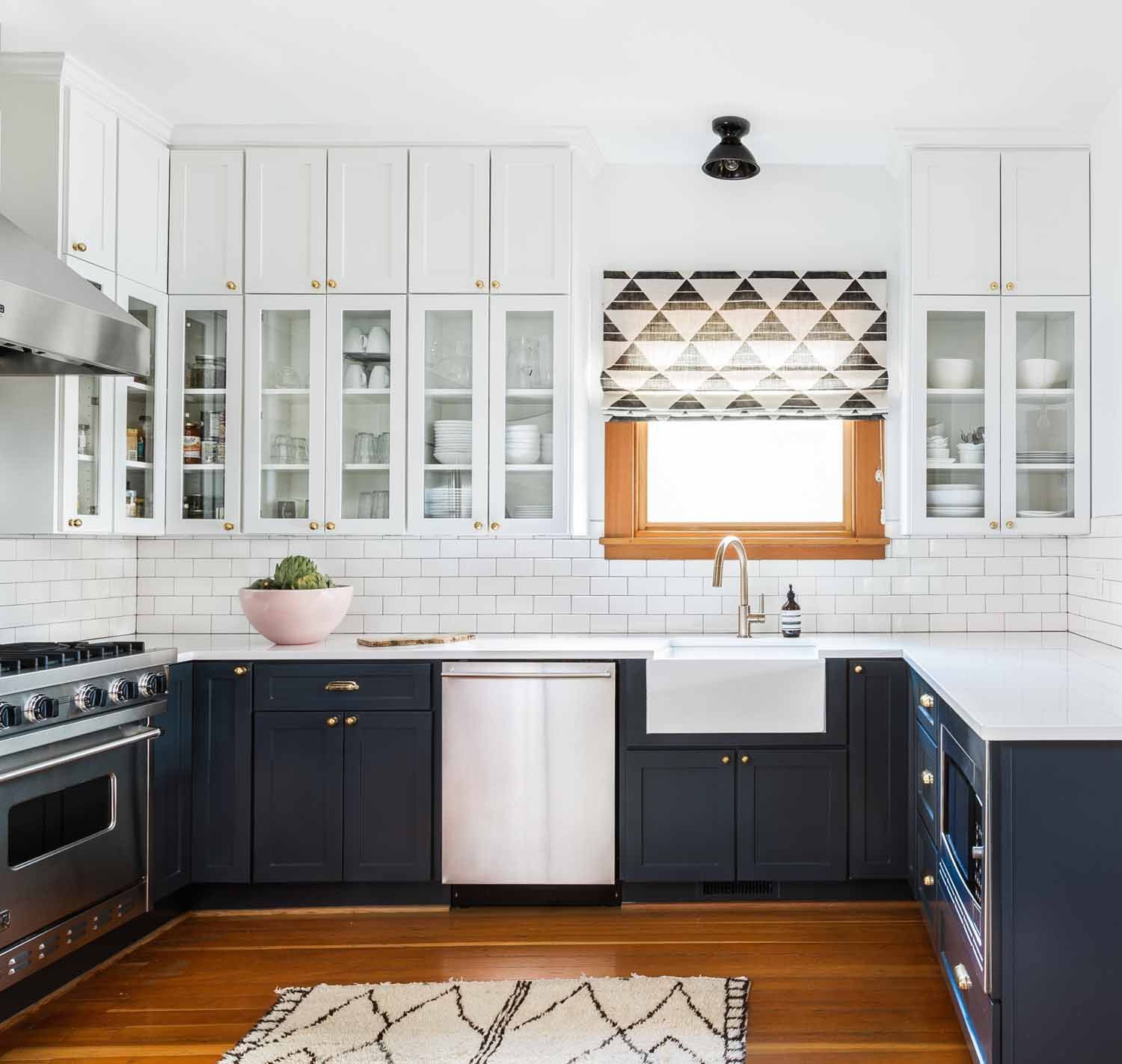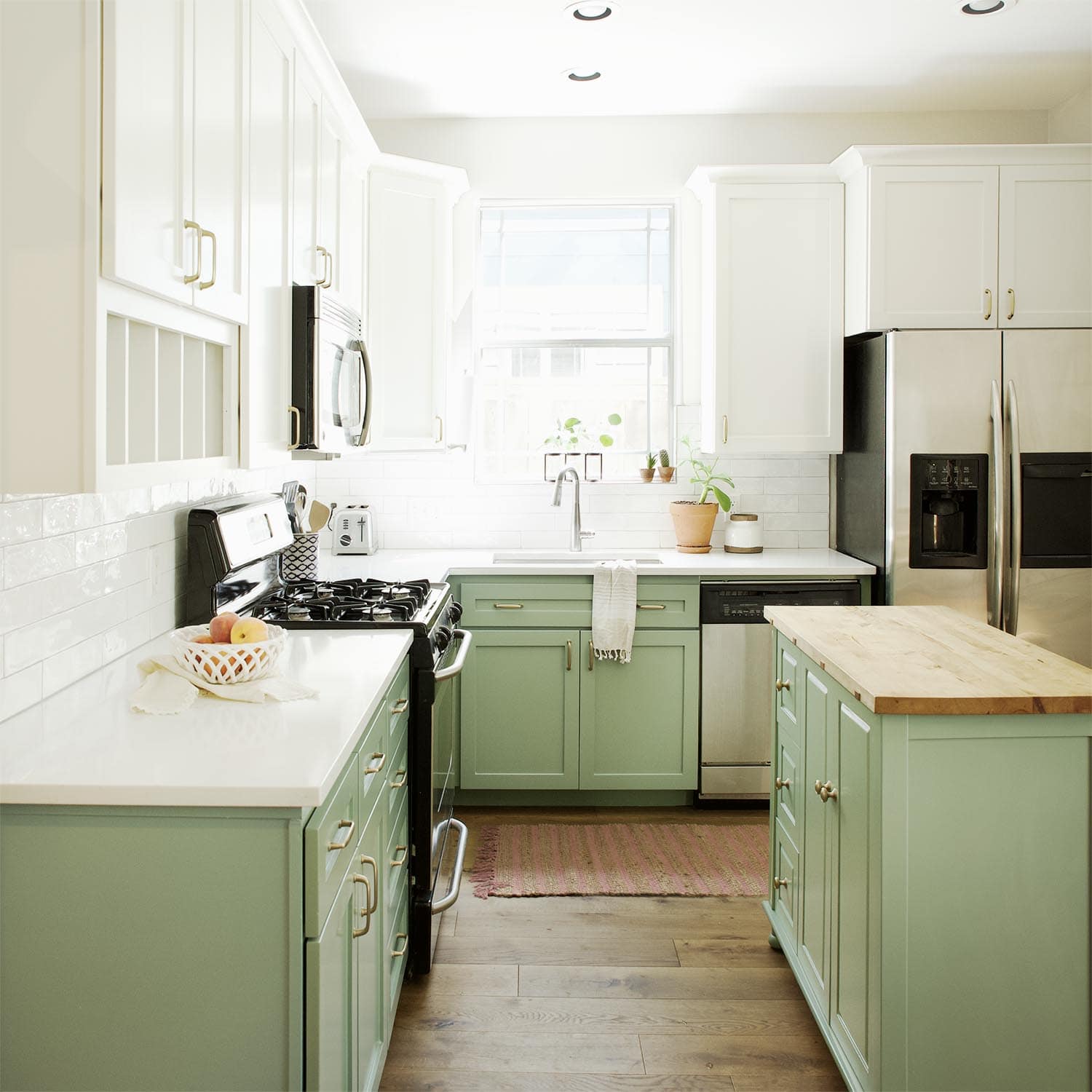Two-Tone Cabinet Design Inspiration: Two Tone Cabinets In Small Kitchen

The allure of two-tone kitchen cabinets lies in their ability to infuse a space with personality and visual interest. In small kitchens, this design strategy takes on an even greater significance, as it offers a unique opportunity to manipulate perception and create an illusion of spaciousness.
Color Combinations for Small Kitchens
The choice of color combinations plays a pivotal role in shaping the perceived size of a small kitchen. Light colors tend to expand a space, while dark colors can make it feel smaller. A judicious blend of light and dark tones can create a harmonious balance, visually enhancing the kitchen’s dimensions.
- Light Base Cabinets with Dark Upper Cabinets: This classic combination creates a sense of height and openness, drawing the eye upwards. Consider pairing a light gray base with a deep navy blue upper for a sophisticated and modern feel.
- Dark Base Cabinets with Light Upper Cabinets: This approach offers a grounding effect, anchoring the space while maintaining a sense of lightness. Think of a rich espresso base paired with a crisp white upper, offering a touch of drama and elegance.
- Two Tones of the Same Color Family: This subtle approach can add visual interest without overwhelming the space. Choose two shades of gray, for instance, a light gray for the base and a darker gray for the upper cabinets, for a cohesive and refined aesthetic.
Choosing Complementary or Contrasting Colors
When selecting colors for a two-tone kitchen, it’s essential to consider the interplay of complementary and contrasting hues.
- Complementary Colors: These colors sit opposite each other on the color wheel, creating a visually stimulating contrast. Examples include blue and orange, red and green, or yellow and purple. Use complementary colors sparingly to avoid overwhelming the space.
- Contrasting Colors: These colors are adjacent to each other on the color wheel, creating a more subtle and harmonious effect. For instance, a blue base cabinet with a green upper cabinet can offer a sense of tranquility and unity.
Accent Colors and Patterns
Accent colors and patterns can add a touch of personality and visual interest to two-tone cabinets.
- Accent Colors: Consider incorporating a vibrant accent color, such as a bold red or a sunny yellow, in the form of hardware, backsplash tiles, or decorative elements. This can add a pop of energy without overwhelming the space.
- Patterns: Incorporate subtle patterns into the cabinet doors, such as a delicate floral motif or a geometric pattern. This can add visual texture and depth without making the space feel cluttered.
Maximizing Space with Two-Tone Cabinets

In the realm of small kitchens, the art of maximizing space is paramount. Two-tone cabinets, with their ability to create visual interest and define distinct zones, offer a powerful tool for achieving this goal. By strategically employing color contrasts and thoughtful design elements, you can transform a compact kitchen into a haven of functionality and style.
Optimizing Layout with Two-Tone Cabinets
A well-designed layout is the foundation of a functional small kitchen. Two-tone cabinets can enhance this functionality by visually separating different areas and creating a sense of order.
- Upper and Lower Cabinet Distinction: Consider using a lighter color for upper cabinets to create a sense of openness and height, while a darker shade for lower cabinets can ground the space and provide a sense of stability. This contrast visually expands the space and adds a touch of sophistication.
- Island Design: If space permits, an island can be a game-changer in a small kitchen. Opting for a two-tone design for the island can further enhance its impact. For instance, a white island with a dark countertop creates a striking focal point and adds a touch of drama to the space.
- Open Shelving: Incorporating open shelving can provide a sense of airiness and create a visually appealing display area for your favorite kitchenware. Pairing open shelving with closed cabinets allows for a balanced approach to storage and aesthetics.
Cabinet Styles and Configurations
The choice of cabinet styles and configurations significantly impacts the functionality and aesthetic of a small kitchen.
- Shaker Cabinets: Known for their simple and timeless design, shaker cabinets offer a clean and uncluttered look, perfect for smaller kitchens.
- Modern Cabinets: With their sleek lines and minimalist aesthetic, modern cabinets can create a sense of spaciousness and sophistication in a small kitchen.
- Traditional Cabinets: Traditional cabinets with ornate details and raised panels can add a touch of elegance to a small kitchen.
The Power of Mirrors and Light Colors, Two tone cabinets in small kitchen
Mirrors and light colors are powerful allies in the quest to create an illusion of more space in a small kitchen.
- Mirrors: Strategically placed mirrors can reflect light and visually expand the space, creating a sense of depth and openness.
- Light Colors: Opting for light colors on walls and ceilings can further amplify the effect of mirrors and create a bright and airy atmosphere.
Visual Representation of a Small Kitchen Layout
Imagine a small kitchen with a U-shaped layout. The upper cabinets are painted a soft white, while the lower cabinets are a warm gray, creating a subtle yet impactful contrast. The countertop is a sleek black, providing a grounding element and a sophisticated touch. An open shelving unit is strategically placed above the sink, displaying a curated collection of kitchenware. A small island with a white base and a dark countertop serves as a focal point, providing additional storage and work space. A large mirror positioned on the backsplash reflects light and visually expands the space, while the light-colored walls and ceiling create a sense of airiness. This design maximizes storage, functionality, and visual appeal, transforming a small kitchen into a welcoming and efficient space.
Styling Two-Tone Cabinets in a Small Kitchen

Two tone cabinets in small kitchen – In the realm of kitchen design, two-tone cabinets have emerged as a captivating trend, offering a unique opportunity to infuse personality and depth into even the smallest spaces. This technique, where upper and lower cabinets are adorned with contrasting hues, allows for a harmonious blend of visual interest and functionality. The art of styling two-tone cabinets lies in harmonizing colors, textures, and finishes to create a cohesive and inviting ambiance.
Hardware and Finishes that Complement Two-Tone Cabinets
The choice of hardware and finishes plays a pivotal role in shaping the overall aesthetic of a two-tone kitchen. These elements can accentuate the color contrast, add a touch of sophistication, or create a sense of continuity throughout the space.
- Metallic Finishes: Brushed nickel, polished chrome, or matte black hardware complements both contemporary and traditional styles, adding a touch of elegance and sophistication.
- Warm Tones: For a more inviting and cozy feel, consider using brass or copper hardware. These finishes complement warm color palettes and create a sense of warmth and richness.
- Matching Hardware: Maintaining a consistent hardware style across both upper and lower cabinets can create a sense of unity and balance. This approach is particularly effective when using contrasting colors.
- Contrasting Hardware: For a bolder statement, consider using contrasting hardware finishes on the upper and lower cabinets. For instance, pairing brushed nickel with black hardware can add a touch of drama and visual intrigue.
Countertop Materials and Backsplash Choices
The selection of countertop materials and backsplash choices significantly impacts the overall aesthetic of a small kitchen with two-tone cabinets. These elements create a visual flow and can either complement or contrast the cabinet colors.
- Neutral Countertop Colors: Neutral countertop colors like white, gray, or beige provide a versatile backdrop that allows the two-tone cabinets to take center stage. This approach creates a sense of spaciousness and allows the colors to shine.
- Complementary Countertop Colors: Countertops in colors that complement the cabinet hues can create a cohesive and harmonious look. For instance, a warm gray countertop can complement a combination of light blue and white cabinets.
- Contrasting Countertop Colors: For a bolder statement, consider using a countertop color that contrasts with the cabinet hues. A black countertop can create a striking contrast with white and gray cabinets, adding a touch of drama and sophistication.
- Backsplash Choices: The backsplash serves as a visual bridge between the countertop and the cabinets, adding texture and visual interest.
- Subtle Backsplash: A subtle backsplash in a neutral color or a simple pattern can complement a two-tone kitchen without overpowering the cabinet colors.
- Bold Backsplash: A bold backsplash in a contrasting color or a statement pattern can create a focal point and add visual interest.
- Matching Backsplash: A backsplash that matches one of the cabinet colors can create a cohesive and elegant look.
Lighting Solutions for a Two-Tone Kitchen
Lighting plays a crucial role in enhancing the visual appeal of a two-tone kitchen. Strategic lighting can highlight the color contrast, create a warm and inviting ambiance, and showcase the beauty of the space.
- Under-Cabinet Lighting: Under-cabinet lighting provides functional task lighting and highlights the countertop and backsplash area. This type of lighting can also create a sense of depth and dimension.
- Pendant Lighting: Pendant lights can be used over the kitchen island or dining area to add a touch of style and create a focal point.
- Recessed Lighting: Recessed lighting provides general illumination and can be used to create a balanced and evenly lit space.
- Ambient Lighting: Ambient lighting, such as table lamps or sconces, can add warmth and create a cozy atmosphere.
Small Kitchen Design with Two-Tone Cabinets and a Cohesive Color Palette
Consider a small kitchen featuring two-tone cabinets, where the upper cabinets are painted a soft sage green and the lower cabinets are a crisp white. The countertop is a warm gray quartz, providing a neutral backdrop that complements both cabinet colors. The backsplash is a subtle white subway tile, adding a touch of texture without overpowering the color scheme. The appliances are stainless steel, adding a modern touch and blending seamlessly with the neutral palette. The decor incorporates accents of sage green, white, and natural wood tones, creating a sense of warmth and cohesion. The textiles, such as curtains or kitchen towels, feature a simple white pattern with subtle hints of sage green, adding a touch of visual interest and tying the entire design together.
Two-tone cabinets are a fantastic way to add visual interest and dimension to a small kitchen. A popular and timeless choice is to pair darker lower cabinets with lighter upper cabinets, creating a sense of spaciousness and airiness. This classic combination, like grey cabinets and white countertops , offers a clean and elegant look.
By incorporating two-tone cabinets, you can create a small kitchen that feels both stylish and functional, a space that inspires you to cook and enjoy your culinary creations.
Two-tone cabinets can add a touch of playful contrast to a small kitchen, but if you’re looking for a truly open and airy feel, consider exploring kitchen designs without wall cabinets. This modern approach maximizes natural light and creates a sense of spaciousness.
If you’re set on two-tone cabinets, consider using a lighter shade on the lower cabinets to visually lift the space.